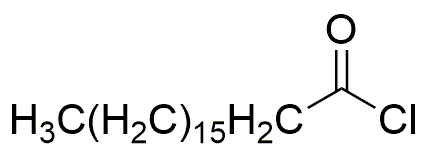Stearoyl chloride is widely utilized in research focused on:
- Surfactant Production: It serves as a key ingredient in the formulation of surfactants used in detergents and personal care products, enhancing cleaning efficiency and foaming properties.
- Pharmaceutical Synthesis: This compound is important in the synthesis of various pharmaceuticals, particularly in the preparation of fatty acid derivatives that can improve drug solubility and bioavailability.
- Polymer Chemistry: Stearoyl chloride is used to modify polymers, providing improved thermal stability and mechanical properties, which is beneficial in the production of high-performance materials.
- Food Industry: It plays a role in food processing as an emulsifier, helping to stabilize mixtures of oil and water, which is essential in products like margarine and dressings.
- Cosmetic Formulations: The compound is utilized in cosmetic products for its emollient properties, contributing to smoother textures and better skin feel in creams and lotions.
General Information
Properties
Safety and Regulations
Applications
Stearoyl chloride is widely utilized in research focused on:
- Surfactant Production: It serves as a key ingredient in the formulation of surfactants used in detergents and personal care products, enhancing cleaning efficiency and foaming properties.
- Pharmaceutical Synthesis: This compound is important in the synthesis of various pharmaceuticals, particularly in the preparation of fatty acid derivatives that can improve drug solubility and bioavailability.
- Polymer Chemistry: Stearoyl chloride is used to modify polymers, providing improved thermal stability and mechanical properties, which is beneficial in the production of high-performance materials.
- Food Industry: It plays a role in food processing as an emulsifier, helping to stabilize mixtures of oil and water, which is essential in products like margarine and dressings.
- Cosmetic Formulations: The compound is utilized in cosmetic products for its emollient properties, contributing to smoother textures and better skin feel in creams and lotions.
Documents
Safety Data Sheets (SDS)
The SDS provides comprehensive safety information on handling, storage, and disposal of the product.
Product Specification (PS)
The PS provides a comprehensive breakdown of the product’s properties, including chemical composition, physical state, purity, and storage requirements. It also details acceptable quality ranges and the product's intended applications.
Certificates of Analysis (COA)
Search for Certificates of Analysis (COA) by entering the products Lot Number. Lot and Batch Numbers can be found on a product’s label following the words ‘Lot’ or ‘Batch’.
*Catalog Number
*Lot Number
Certificates Of Origin (COO)
This COO confirms the country where the product was manufactured, and also details the materials and components used in it and whether it is derived from natural, synthetic, or other specific sources. This certificate may be required for customs, trade, and regulatory compliance.
*Catalog Number
*Lot Number
Safety Data Sheets (SDS)
The SDS provides comprehensive safety information on handling, storage, and disposal of the product.
DownloadProduct Specification (PS)
The PS provides a comprehensive breakdown of the product’s properties, including chemical composition, physical state, purity, and storage requirements. It also details acceptable quality ranges and the product's intended applications.
DownloadCertificates of Analysis (COA)
Search for Certificates of Analysis (COA) by entering the products Lot Number. Lot and Batch Numbers can be found on a product’s label following the words ‘Lot’ or ‘Batch’.
*Catalog Number
*Lot Number
Certificates Of Origin (COO)
This COO confirms the country where the product was manufactured, and also details the materials and components used in it and whether it is derived from natural, synthetic, or other specific sources. This certificate may be required for customs, trade, and regulatory compliance.

